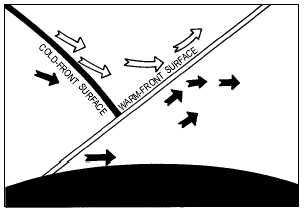Upper Air Characteristics
If only one upper air sounding were taken so that it
intersected either the cold or warm front, the sounding
would appear as a typical warm or cold front sounding.
However, if the sounding were taken so that it
intersected both the cold and warm air, it would show
two inversions.
The occlusion may appear on some upper air
charts. It usually appears on the 850-mb chart, but
rarely on the 700-mb chart. As the two air masses are
brought closer together and as the occlusion process
brings about gradual disappearance of the warm sector,
the isotherm gradient associated with the surface front
weakens. The degree of weakening depends on the
horizontal temperature differences between the cold air
to the rear of the cold front and that ahead of the warm
front. The angle at which the isotherms cross the
surface position of the occluded fronts becomes greater
as the temperature contrast between the two cold air
lasses decreases. A typical illustration of the isotherms
shows a packing of isotherms in the cold mass behind
the cold front and less packing in the cool mass in
advance of the warm front. A warm isotherm ridge
precedes the occlusion aloft.
WARM OCCLUSIONS
A warm occlusion is the occlusion that forms when
the overtaking cold front is lifted by overrunning the
colder retreating air associated with the warm front.
This is shown in figure 4-40.
The warm occlusion
usually develops in the Northern Hemisphere when
conditions north and of ahead of the warm front are
such that low pa temperatures exist north of the warm
front. This usually occurs along the west coasts of
continents when a relatively cool maritime cold front
overtakes a warm front associated with a very cold
continental air mass of high pressure situated over the
western portion of the continent. The cold front then
continues as an upper cold front above the warm front
surface. The occlusion is represented as a continuation
of the warm front. The cold front aloft is usually
represented on all surface charts. Figure 4-41 depicts a
typical warm type of occlusion in both the vertical and
horizontal.
Surface Characteristics
The warm type of occlusion has the same type of
pressure pattern as the cold type of occlusion. The most
reliable identifying characteristics of the upper front
are a line of marked cold frontal precipitation and
clouds ahead of the occluded front, a slight but distinct
pressure trough and a line of pressure-tendency
discontinuities.
NOTE: The pressure tendency shows a steady fall
ahead of the upper cold front and, with passage, a
leveling off for a short period of time. Another slight
fall is evident with the approach of the surface position
of the occlusion. After passage the pressure shows a
steady rise.
The pressure trough is often more distinct with the
upper front than with the surface front.
Weather
The weather associated with warm front occlusions
has the characteristics of both warm and cold fronts.
The sequence of clouds ahead of the occlusion is
similar to the sequence of clouds ahead of a warm front;
the cold front weather occurs near the upper cold front.
If either the warm or cool air that is lifted is moist and
unstable, showers and sometimes thunderstorms may
develop. The intensity of the weather along the upper
front decreases with distance from the apex. Weather
conditions change rapidly in occlusions and are usually
most severe during the initial stages. However, when
the warm air is lifted to higher and higher altitudes, the
weather activity diminishes. When showers and
thunderstorms occur, they are found just ahead and with
the upper cold front. Normally, there is clearing
weather after passage of the upper front, but this is not
always the case.
Upper Air Characteristics
Upper air soundings taken through either front
show typical cold or warm front soundings. Those
4-42
COLD AIR
COLDER AIR
WARM AIR
WARM TYPE OF OCCLUSION
AG5f0440
Figure 4-40.—Vertical cross-section of a warm type of
occlusion.


